Ijraset Journal For Research in Applied Science and Engineering Technology
- Home / Ijraset
- On This Page
- Abstract
- Introduction
- Conclusion
- References
- Copyright
Robust Transmission using Efficient Adaptive Modulation and Coding in Modern OFDM Systems
Authors: Ameykumar Arunrao Patil, Dr. C M Jadhao, Prof. S S Mhaske, Dr. R R Karhe
DOI Link: https://doi.org/10.22214/ijraset.2023.52336
Certificate: View Certificate
Abstract
OFDM (Orthogonal Frequency Division Multiplexing) as a special multi-carrier transmission technology has good resistance to narrow-band interference and frequency selective fading ability. Using adaptive modulation and coding in an OFDM systems in comparison with traditional fixed modulation techniques, it becomes possible to take full advantage of spectrum resources enhancing bandwidth efficiency and system capacity making it suitable for the high-speed and reliable mobile communication systems in the future. In AMC (Adaptive Modulation and Coding) technique, modulation method, coding rate, and/or other signal transmission parameters are dynamically adapted to the channel conditions to increase the system performance in terms of Bit Error Rate (BER) and throughput (bps) in various conditions such as channel mismatch, Doppler spreads, fading, etc. The purpose of this paper is to investigate the effect of adaptive modulation and coding in an OFDM system in terms of bit error rate and SNR over fading communication channels. In this paper, we have considered fixed and adaptive modulation technique in an OFDM system over AWGN and RICEAN channel with convolutional and BCH coding. An OFDM system model is simulated in MATLAB programming environment to obtain the simulation result. From the comparative simulation result analysis in terms of BER v/s SNR, it can be concluded that Adaptive modulation with Convolutional coding over RICEAN channel significantly reduces bit error rate giving better trade-off between SNR and BER than all other options considered here.
Introduction
I. INTRODUCTION
With the advancement in the communications technology, the demand for higher data rate services such as multimedia, voice, and data over both wired and wireless links is also increased. Many transmission systems can not easily adapt to severe channel conditions without complex time-domain equalization. These systems are not robust against narrow-band co-channel interference, inter symbol interference (ISI) and fading caused by multipath propagation. Also they are very much sensitive to time synchronization errors. Therefore, advanced digital transmission standard is required to transfer the large amount of data with robustness against narrow-band co-channel interference, inter symbol interference (ISI) and fading caused by multipath propagation with high data rate, allowable Bit Error Rate (BER), and maximum spectral efficiency. Orthogonal Frequency Division Multiplexing (OFDM) is the best solution for it. Orthogonal Frequency Division Multiplexing (OFDM) is a type of digital transmission used in digital modulation for encoding digital (binary) data on multiple carrier frequencies. OFDM has developed into a popular scheme for wideband digital communication, used in applications such as digital television and audio broadcasting, DSL internet access, wireless networks, power line networks, and 4G/5G mobile communications.
In an OFDM transmission system, each subcarrier is attenuated individually under the frequency-selective and fast fading channel. The channel performance may be highly fluctuating across the subcarriers and varies from symbol to symbol. If the same fixed transmission scheme is used for all OFDM subcarriers, the error probability is dominated by the OFDM subcarriers with highest attenuation resulting in a poor performance. Therefore, in case of frequency selective fading the error probability decreases very slowly with increasing average signal-to-noise ratio (SNR). This problem can be mitigated if different modulation schemes are employed for the individual OFDM subcarriers. The resilience to severe channel conditions can be further enhanced if information about the channel is sent over a return-channel. Based on this feedback information, adaptive modulation, channel coding and power allocation may be applied across all subcarriers, or individually to each subcarrier. In the latter case, if a particular range of frequencies suffers from interference or attenuation, the carriers within that range can be disabled or made to run slower by applying more robust modulation or error coding to those subcarriers. Therefore in adaptive transmission (adaptive modulation and coding) in OFDM system can maintain a constant performance by varying transmitted power level, modulation scheme, coding rate or any combination of these schemes. This allows us to vary the data rate without sacrificing BER performance. Thus, Adaptive modulation and coding can be an effective way to achieve with high data rate, allowable Bit Error Rate (BER), and maximum spectral efficiency to transmit multimedia information over mobile wireless channels.
II. RELATED WORK
N.K.Noordin et al.[2],2004 presented a review on various link adaptation techniques used in OFDM transmission and interpreted that coded OFDM performs better in terms of SNR requirements as compared to uncoded system in any QAM modulation. J.Faezah et al.[4],2009 proposes an adaptive transmission scheme according to channel fading condition in OFDM to improve the performance and found that with adaptive modulation and convolutional coding there is significant improvements in terms of bit error rate (BER) and throughput as compared to fixed transmission schemes. D. Sreenivasa Rao et al.[5],2010 proposed a MPC algorithm using higher order modulation schemes such as 256-QAM and 128-QAM at low SNR values in order to reduce PAPR and enhance the data rate without degrading the SER performance especially at low SNR values. Rajeshree Raut et.al.[7],2012 proposed that the highest spectral efficiency with the lowest possible combining complexity, given the fading channel conditions and the required error rate performance increases the spectral efficiency with a slight increase in the average number of combined path for the low signal to noise ratio (SNR) range while maintaining compliance with the bit error rate (BER). Serkout N. Abdullah et al.[8],2012 proposed that an adaptive coded modulation for coded OFDM system using punctured convolutional code, channel estimation, equalization and SNR estimation maintains fixed BER under changing channel conditions. Manjushree Bhardwaj et al.[11],2012 proposed that an OFDM is one of the techniques for parallel transmission used to achieve high throughput and better transmission quality. The basics of OFDM techniques, role of OFDM in this era, its benefits and losses and also some of its application are discussed. T.S.Harivikram et al.[14], 2013 proposed that an OFDM has been recently applied widely in wireless communication systems due to its high data rate transmission capability with high bandwidth efficiency and its robustness to multipath delay. Mewara et al.[15],2015 proposed that the information rates and channel limit of a wireless MIMO OFDM framework can be enhanced by executing a dynamic connection adjustment calculation (Link Adaption Algorithm). Spatially Adaptive Modulation and Coding (SAMC) plan is implemented. T. Jaya et al.[16], 2016 proposed that an adaptive OFDM provides maximum data rate, robustness against multipath fading and bandwidth saving up to fifty percentage compared to conventional methods. The performance of the system is improved according to the channel fading conditions, when adaptive modulation is employed. Nandi et al.[17], 2017 proposed that ISI and ICI are reduced to a great extent with use of OFDM. A Cyclic Prefix (CP) is inserted between OFDM symbols to eliminate both the ISI and ICI. The effect of the CP on the BER is evaluated with Cyclic prefix OFDM using adaptive modulation technique. Suchi Barua et al.[18],2020 proposed that a real-time OFDM based adaptive UA communication system, the SNR calculated at the receiver for clusters (group of subcarriers) to reduce the computational and feedback load is used as a performance metric to switch the modulation mode of each cluster which is fed back to the transmitter for data transmission. Ravi Kumar M G et al.[19], 2021 proposed an idea of MIMO-OFDM receiver design using Adaptive modulation and channel estimation for underwater acoustic communication. In this work, the channel is estimated using Kalman filter, a well-known algorithm for estimation and prediction especially when data has a lot of noise. Rahim Khan et al.[20], 2021 proposed that an adaptive modulation under various parameters, such as signal to interference plus noise ratio (SINR), and communication channels distances minimize bit error rate (BER), improve throughput and utilize the available bandwidth efficiently.
III. PROPOSED RESEARCH WORK
This research work investigates the comparative performance evaluation of OFDM systems without and with adaptive modulation method using convolutional coding and BCH coding over AWGN and Rician channel. OFDM system model is simulated using MATLAB programming.
Following methodological steps are adopted for this performance evaluation
- An OFDM system model using Fixed Modulation methods (QPSK,16-QAM and 64-QAM) and adaptive modulation method with convolutional coding and BCH coding over AWGN channel is simulated using MATLAB programming. The simulation results are obtained in terms of SNR v/s BER characteristics.
- An OFDM system model using Fixed Modulation methods (QPSK,16-QAM and 64-QAM) and adaptive modulation method with convolutional coding and BCH coding over Rician channel is simulated using MATLAB programming. The simulation results are obtained in terms of SNR v/s BER characteristics.
- The comparative simulation result analysis in terms of SNR V/s BER characteristics of an OFDM system model without and with adaptive modulation method using convolutional and BCH coding over AWGN and Ricean channel is used to interpret the results for performance evaluation.
A. OFDM System Model with Adaptive Modulation and Coding
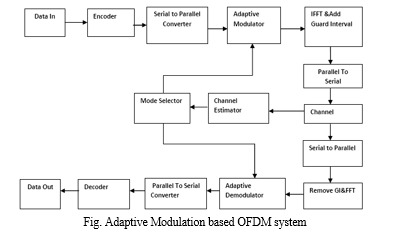
The schematic illustration of the Adaptive modulation based OFDM technique is shown in fig. The input data is encoded and go after by Serial-to-Parallel(S/P) converter to give low rate sub streams. Each user symbol is then modulated in parallel by suitable modulation techniques, such as Quadrature PSK, and M-PSK etc.
The Inverse FFT block converts frequency domain samples into time domain samples and still it maintains the orthogonality between subcarriers. The effect of ISI on symbol can be reduced by the adding guard period at the starting and ending of every frame. Guard band interval should be higher than the delay spread of the channel. After the guard interval has been included, the signals are changed into serial form. An AWGN model is then added with the transmitted signal. This model tolerates for the Signal to Noise Ratio variations. The receiver executes the reverse process of the transmitter.
The receiver section removes the guard band interval, FFT process and decoding of data. The adaptive OFDM model consists of adaptive switch. The input information is formatted into word depends on the modulation method need for transmission. At the receiver section, the SNR value is calculated by using above formula and this value is directly applied to the mode selector block through the channel estimator. Based on this SNR value the mode selector switch chooses the correct modulation technique, which satisfy the threshold limit.
B. Additive White Gaussian Noise Model
The simplest radio environment in which a wireless communications system or a local positioning system or proximity detector based on Time of flight will have to operate is the Additive-White Gaussian Noise (AWGN) environment. Additive white Gaussian noise (AWGN) is the commonly used to transmit signal while signals travel from the channel and simulate background noise of channel. The mathematical expression in received signal r(t) = s(t) + n(t) that passed through the AWGN channel where s(t) is transmitted signal and n(t) is background noise.
C. Rician Fading Model
Ricean fading is a stochastic model for radio propagation anomaly caused by partial cancellation of a radio signal by itself the signal arrives at the receiver by several different paths (hence exhibiting multipath interference), and at least one of the paths is changing (lengthening or shortening). Rician fading occurs when one of the paths, typically a line of sight signal or some strong reflection signals, is much stronger than the others. In Rician fading, the amplitude gain is characterized by a Rician distribution.
D. Bit Error Rate (BER)
The BER, or quality of the digital link, is calculated from the number of bits received in error divided by the number of bits transmitted. BER= (Bits in Error) / (Total bits received). In digital transmission, the number of bit errors is the number of received bits of a data stream over a communication channel that has been altered due to noise, interference, distortion or bit synchronization errors. The BER is the number of bit errors divided by the total number of transferred bits during a particular time interval. BER is a unit less performance measure, often expressed as a percentage.
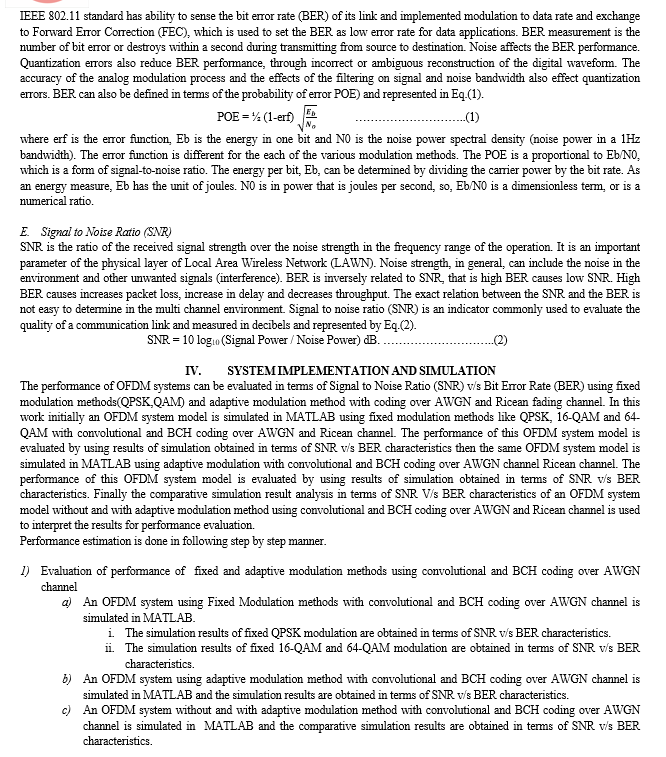
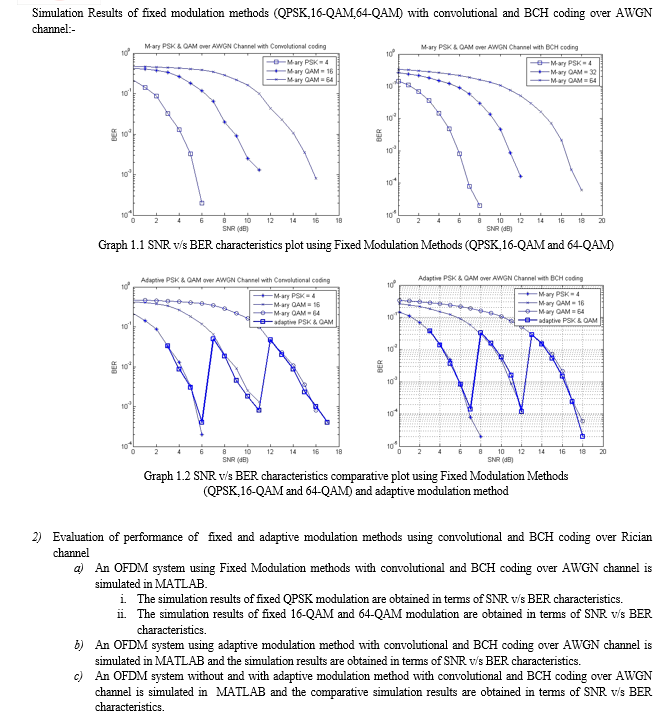
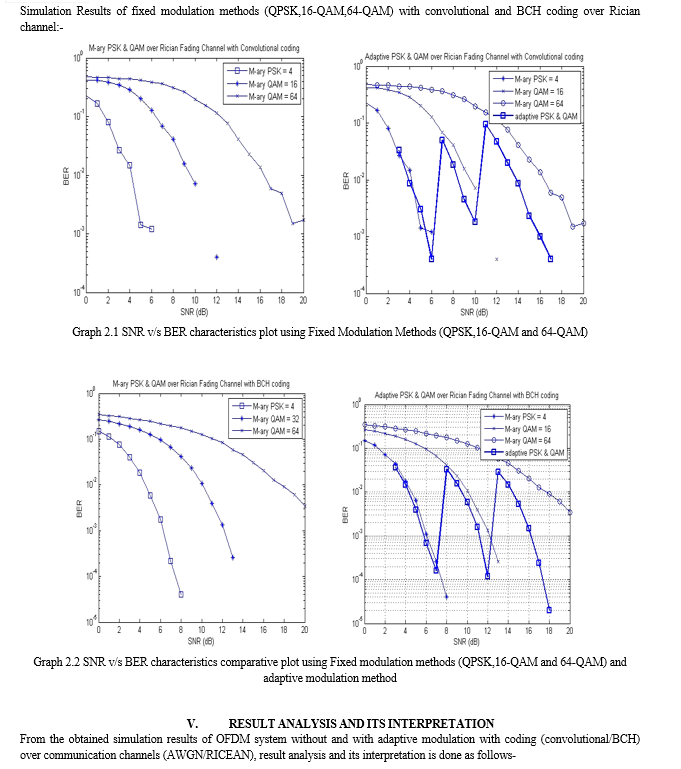
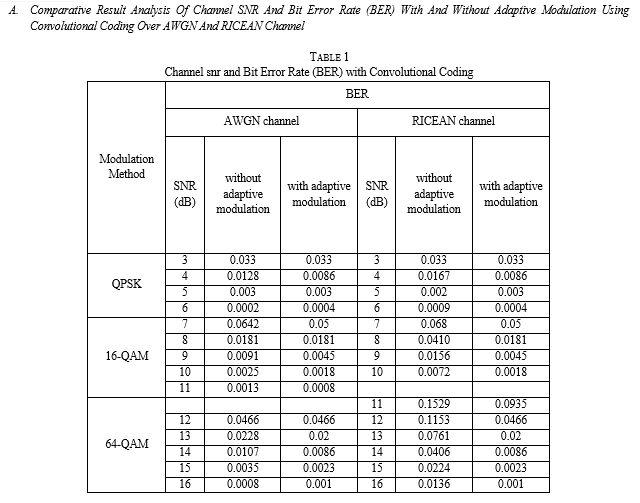
The obtained results shows that-
- For the lower SNR values in the range of 4-6dB, BER varies from 0.0128 to 0.0002 for QPSK Modulation with convolutional coding over AWGN and RICEAN. In this range, there is no improvement in BER with the use of adaptive modulation over AWGN as well as RICEAN channel.
- For the middle SNR values in the range of 8-10dB, BER varies from 0.0181 to 0.0018 for 16-QAM Modulation with convolutional coding over AWGN and RICEAN channel. In this range, for SNR value of 9dB, there is 50.5% reduction in BER with the use of adaptive modulation over AWGN channel whereas for same SNR value of 9dB, there is 71.15% reduction in the BER value with adaptive modulation over RICEAN channel.
- For the higher SNR values in the rage of 13-15dB, BER varies from 0.0228 to 0.0023 for 64-QAM Modulation with convolutional coding over AWGN and RICEAN channels. In this range for SNR value of 14dB, there is 19.62% reduction in BER with the use of adaptive modulation over AWGN channel whereas for same SNR value of 14dB, there is 78.81% reduction in the BER value with adaptive modulation over RICEAN channel.
- Thus, from this analysis it can be interpreted that there is no improvement in BER for SNR values in lower range with adaptive modulation but reduction in the BER is observed for middle and higher ranges of SNR by using adaptive modulation and convolutional coding over AWGN and RICEAN channels.
B. Comparative Result Analysis Of Channel Snr And Bit Error Rate (Ber) With And Without Adaptive Modulation Using Bch Coding Over Awgn And Ricean Channel
Table 2
channel snr and bit error rate(ber) with BCH coding
|
Modulation Method |
BER |
|||||
|
AWGN Channel |
RICEAN Channel |
|||||
|
SNR (dB) |
without adaptive modulation |
with adaptive modulation |
SNR (dB) |
without adaptive modulation |
with adaptive modulation |
|
|
QPSK |
3 |
0.038 |
0.038 |
3 |
0.04072 |
0.03628 |
|
4 |
0.0151 |
0.0151 |
4 |
0.0185 |
0.0123 |
|
|
5 |
0.00402 |
0.00402 |
5 |
0.00588 |
0.00284 |
|
|
6 |
0.00064 |
0.00064 |
6 |
0.00174 |
0.0007 |
|
|
7 |
0.0002 |
0.0002 |
7 |
0.00022 |
0.00014 |
|
|
16-QAM |
8 |
0.03428 |
0.03428 |
8 |
0.04108 |
0.03242 |
|
9 |
0.01484 |
0.01484 |
9 |
0.02342 |
0.01514 |
|
|
10 |
0.00526 |
0.00526 |
10 |
0.0108 |
0.00594 |
|
|
11 |
0.0008 |
0.0008 |
11 |
0.00396 |
0.00158 |
|
|
12 |
0.00008 |
0.00008 |
12 |
0.00136 |
0.00016 |
|
|
64-QAM |
13 |
0.02968 |
0.02968 |
13 |
0.05812 |
0.03004 |
|
14 |
0.01514 |
0.01514 |
14 |
0.04666 |
0.01546 |
|
|
15 |
0.00578 |
0.00578 |
15 |
0.03062 |
0.006461 |
|
|
16 |
0.00188 |
0.00188 |
16 |
0.02064 |
0.00192 |
|
|
17 |
0.0042 |
0.00036 |
17 |
0.01274 |
0.00036 |
|
|
18 |
0.00006 |
0.00008 |
18 |
0.008981 |
0.00002 |
|
The obtained results shows that-
- For the lower SNR values in the range of 4-6dB, BER varies from 0.0151 to 0.0007 for QPSK Modulation with BCH coding over AWGN and RICEAN channels. In this range, for SNR value of 5dB, there is no improvement in BER with the use of adaptive modulation over AWGN channel whereas for same SNR value of 5dB, there is 51.7% reduction in the BER value with adaptive modulation over RICEAN channel.
- For the middle SNR values in the range of 8-10dB, BER varies from 0.03428 to 0.00526 for 16-QAM Modulation with BCH coding over AWGN and RICEAN channels. In this range, for SNR value of 9dB, there is no improvement in BER with the use of adaptive modulation over AWGN channel whereas for same SNR value of 9dB, there is 35.35% reduction in the BER value with adaptive modulation over RICEAN channel.
- For the higher SNR range of 13-15dB, BER varies from 0.02968 to 0.006461 for 64-QAM Modulation with BCH coding over AWGN and RICEAN channels. In this range, for SNR value of 14dB, there is no improvement in BER with the use of adaptive modulation over AWGN channel whereas for same SNR value of 14dB, there is 66.86% reduction in the BER value with adaptive modulation over RICEAN channel.
- Thus, from this analysis it can be interpreted that with Adaptive modulation and BCH coding, there is no improvement in channel performance in terms of BER over a AWGN channel but there is significant improvement in the channel performance with reduction in BER values by using adaptive modulation and BCH coding over RICEAN channel.
C. Comparative Result Analysis Of Channel Snr Range And Average Bit Error Rate (Ber) With And Without Adaptive Modulation Using Convolutional Coding Over Awgn And Ricean Channel
Table 3
channel snr RANGE and AVERAGE bit error rate(ber) with CONVOLUTIONAL coding
|
Modulation Method |
SNR Range |
AVERAGE BER |
|||
|
AWGN channel |
RICEAN channel |
||||
|
without adaptive modulation |
with adaptive modulation |
without adaptive modulation |
with adaptive modulation |
||
|
QPSK |
4dB-6dB |
0.0053 |
0.004 |
0.0065 |
0.004 |
|
16-QAM |
8dB-10dB |
0.0099 |
0.0081 |
0.0212 |
0.0081 |
|
64-QAM |
13dB-15dB |
0.0123 |
0.0103 |
0.0463 |
0.0103 |
The obtained results shows that-
- For the lower SNR values in the range of 4-6dB, QPSK with convolutional coding without adaptive modulation, average BER value is 0.0053 for AWGN channel and 0.0065 for RICEAN channel whereas 0.004 (constant) with adaptive modulation for AWGN as well as RICEAN channel. For this SNR range, there is 24.52% reduction in average BER value with the use of adaptive modulation using convolutional coding over AWGN channel whereas there is 38.79% reduction in average BER value with adaptive modulation using convolutional coding over RICEAN channel.
- For the middle SNR values in the range of 8-10dB, 16-QAM with convolutional coding without adaptive modulation, average BER value is 0.0099 for AWGN channel and 0.0212 for RICEAN channel whereas 0.0081(constant) with adaptive modulation for AWGN as well as RICEAN channel. For this SNR range, there is 17.87% reduction in average BER value with the use of adaptive modulation using convolutional coding over AWGN channel whereas there is 61.79% reduction in average BER value with adaptive modulation using convolutional coding over RICEAN channel.
- For the higher SNR values in the range of 13-15dB, 64-QAM with convolutional coding without adaptive modulation, average BER value is 0.0123 for AWGN channel and 0.0463 for RICEAN channel whereas 0.0103(constant) with adaptive modulation for AWGN as well as RICEAN channel. For this SNR range, there is 16.26% reduction in average BER value with the use of adaptive modulation using convolutional coding over AWGN channel whereas there is 77.65% reduction in average BER value with adaptive modulation using convolutional coding over RICEAN channel.
- Thus, from this analysis it can be interpreted that with Adaptive modulation and convolutional coding, there is reduction in the average BER value for all SNR ranges over AWGN as well as RICEAN channel. In terms of channel performance, there is significant reduction in average BER value over RICEAN channel as compared to AWGN channel for entire ranges of SNR by using adaptive modulation with convolutional coding.
D. Comparative Result Analysis Of Channel Snr Range And Average Bit Error Rate (Ber) With And Without Adaptive Modulation Using Bch Coding Over Awgn And Ricean Channel
Table 4
channel snr RANGE and AVERAGE bit error rate(ber) with BCH coding
|
Modulation Method |
SNR Range |
AVERAGE BER |
|||
|
AWGN channel |
RICEAN channel |
||||
|
without adaptive modulation |
with adaptive modulation |
without adaptive modulation |
with adaptive modulation |
||
|
QPSK |
4dB-6dB |
0.0065 |
0.0065 |
0.0087 |
0.0052 |
|
16-QAM |
8dB-10dB |
0.0181 |
0.0181 |
0.0251 |
0.0178 |
|
64-QAM |
13dB-15dB |
0.0168 |
0.0168 |
0.0451 |
0.0173 |
The obtained results shows that-
- For the lower SNR values in the range of 4-6dB, QPSK with BCH coding without adaptive modulation, average BER value is 0.0065 for AWGN channel and 0.0087 for RICEAN channel whereas QPSK with BCH coding and adaptive modulation, average BER value is 0.0065 for AWGN channel and 0.0052 for RICEAN channel. For this SNR range, there is no improvement in average BER value with the use of adaptive modulation using BCH coding over AWGN channel whereas there is 40.22% reduction in average BER value with adaptive modulation using BCH coding over RICEAN channel.
- For the middle SNR values in the range of 8-10dB, 16-QAM with BCH coding without adaptive modulation, average BER value is 0.0181 for AWGN channel and 0.0251 for RICEAN channel whereas 16-QAM with BCH coding and adaptive modulation, average BER value is 0.0181 for AWGN channel and 0.0178 for RICEAN channel. For this SNR range, there is no improvement in average BER value with the use of adaptive modulation using BCH coding over AWGN channel whereas there is 28.96% reduction in average BER value with adaptive modulation using BCH coding over RICEAN channel.
- For the middle SNR values in the range of 13-15dB, 64-QAM with BCH coding without adaptive modulation, average BER value is 0.0168 for AWGN channel and 0.0451 for RICEAN channel whereas 64-QAM with BCH coding and adaptive modulation, average BER value is 0.0168 for AWGN channel and 0.0173 for RICEAN channel. For this SNR range, there is no improvement in average BER value with the use of adaptive modulation using BCH coding over AWGN channel whereas there is 61.62% reduction in average BER value with adaptive modulation using BCH coding over RICEAN channel.
- Thus, from this analysis it can be interpreted that with Adaptive modulation and BCH coding, there is no reduction in the average BER value for all SNR ranges over AWGN channel but average BER reduces significantly over RICEAN channel. In terms of channel performance, there is significant reduction in average BER value over RICEAN channel as compared to AWGN channel for entire ranges of SNR by using adaptive modulation with BCH coding.
???????E. Comparative Result Analysis Of Percentage Improvement In Average Bit Error Rate (Ber) Using Adaptive Modulation And Coding Over Fixed Modulation And Coding
Table 4
channel snr RANGE and AVERAGE bit error rate(ber) with BCH coding
|
PERCENTAGE IMPROVEMENT IN AVERAGE BER USING ADAPTIVE MODULATION AND CODING OVER FIXED MODULATION AND CODING |
|||||
|
CODING |
CONVOLUTIONAL |
BCH |
|||
|
Modulation Scheme |
SNR Range (dB) |
AWGN Channel |
RICEAN Channel |
AWGN Channel |
RICEAN Channel |
|
QPSK |
4-6 |
24.52 |
38.79 |
0 |
40.22 |
|
16-QAM |
8-10 |
17.87 |
61.79 |
0 |
28.96 |
|
64-QAM |
13-15 |
16.26 |
77.65 |
0 |
61.62 |
From the the comparative data analysis it is interpreted that-
- With Adaptive modulation and convolutional coding, there is reduction in the average BER value for all SNR ranges (4dB-15dB) over AWGN as well as RICEAN channel. In terms of channel performance, there is significant reduction in average BER value over RICEAN channel as compared to AWGN channel for entire ranges of SNR by using adaptive modulation with convolutional coding.
- With Adaptive modulation and BCH coding, there is no reduction in the average BER value for all SNR ranges over AWGN channel but average BER reduces significantly over RICEAN channel. In terms of channel performance, there is significant reduction in average BER value over RICEAN channel as compared to AWGN channel for entire ranges of SNR by using adaptive modulation with BCH coding.
- Therefore, the comparative data analysis of percentage improvement in average BER using adaptive modulation and coding over fixed modulation and coding shows that in terms of channel performance, there is significant improvement (reduction) in average BER value for entire ranges of SNR by using adaptive modulation with convolutional coding over RICEAN channel as compared to AWGN channel in comparison with fixed modulation.
Conclusion
In this project, an OFDM system model with Fixed Modulation methods like QPSK, 16-QAM/64-QAM using two channel coding techniques like Convolutional and BCH coding over two communication fading channels like AWGN and RICEAN is simulated in MATLAB programming environment and the results of simulations are obtained in terms of channel SNR v/s BER characteristics for different combinations of these modulation methods, coding techniques and channel types. The same OFDM system model with adaptive modulation approach is then simulated in MATLAB programming environment for different combinations of coding techniques and channel types and the results of simulations are obtained in terms of channel SNR v/s BER characteristics. From the result analysis and its interpretation it can be concluded that- 1) Using adaptive modulation and convolutional coding, there is no improvement in BER in comparison with fixed modulation for SNR values in lower ranges but for middle and higher ranges of SNR , there is considerable reduction in BER values over AWGN as well as RICEAN channel. 2) Using adaptive modulation and BCH coding, there is no reduction in BER over a AWGN channel but there is significant reduction in BER over RICEAN channel. 3) Using adaptive modulation and convolutional coding, there is reduction in the average BER values for all SNR ranges over AWGN as well as RICEAN channel. But in terms of channel performance, there is significant reduction in average BER values over RICEAN channel as compared to AWGN channel. 4) Using adaptive modulation and BCH coding, there is no reduction in the average BER values for all SNR ranges over AWGN channel but average BER reduces significantly over RICEAN channel. So in terms of channel performance, there is significant reduction in average BER value over RICEAN channel as compared to AWGN channel. 5) Therefore it can be concluded that there is reduction in average BER values for entire ranges of SNR by using adaptive modulation with convolutional coding over RICEAN channel as compared to AWGN channel. 6) Hence, adaptive modulation using convolutional coding over RICEAN channel can be a best option in order to achieve the desirable trade-off between Signal to Noise Ratio and Bit Error Rate for an OFDM system. A. Future Scope The performance analysis of OFDM system in terms of channel SNR v/s BER characteristics with adaptive modulation using convolutional and BCH channel coding techniques over AWGN and BCH fading channels gives an idea that OFDM system with adaptive modulation approach using convolutional coding over RICEAN channel can be implemented to achieve better trade off between channel SNR and Bit Error Rate(BER). In the methodology adopted in this project, signal transmission parameters like modulation methods (QPSK,16-QAM,64-QAM) are dynamically adapted to the channel condition (SNR) to increase the system performance in terms of Bit Error Rate (BER). In the same way effect of adaptive modulation on channel performance using higher order modulations with other channel coding techniques than convolutional and BCH over other fading channels than AWGN or RICEAN can also be evaluated in terms of BER and throughput (bps) in various conditions such as channel mismatch, Doppler spreads, fading, etc. so as to have more efficient and robust transmission in an OFDM system.
References
[1] Megha Gupta , Prof. Rajesh Nema , Dr. Ravi Shankar Mishra , Dr. PuranGour, ‘Bit Error Rate Performance in OFDM System Using MMSE &MLSE Equalizer Over Rayleigh Fading Channel through BPSK, QPSK, 4-QAM & 16-QAM Modulation Technique’, IJERA,2002 [2] N. K. Noordin, B. M. Ali, N. Ismail, and S.S. Jamuar, ‘Adaptive Techniques In Orthogonal Frequency Division Multiplexing in Mobile Radio Environment, International Journal of Engineering and Technology,2004 [3] Mrs. C. Geetha Priya, Dr. Mrs. M. Sunganthi, M. Madhana Prabha, ‘Improving the Data Rate of OFDM System in Rayleigh Fading Channel Using Spatial Multiplexing with Different ModulationTechniques’, International Symposium on Computing, Communication and Control (ISCCC 2009) [4] J.Faezah and K. Sabira, Adaptive Modulation for OFDM Systems, International Journal of Communication Networks and Information Security (IJCNIS), August 2009 [5] D. Sreenivasa Rao, M. Kanti Kiran & K. Sri Ramakrishna, Algorithm to improve the Performance of OFDM based WLAN Systems, International Journal of Computer Science & Communication, July-December 2010 [6] Susmita Das, Srabani Mohapatra and Kala Praveen Bagadi, Performance improvement of OFDM System By Peak To Average Power Reduction through Pulse Shaping Technique, ICTACT Journal On Communication Technology, December 2010 [7] Rajeshree Raut and Priti Subramanium, Optimize Adaptive Coding Techniques to improve BER in OFDM System, International Journal of Electronics Communication and Computer Engineering, [8] Dr. Serkout N. Abdullah Zainab Mageed Abid, Adaptive Coded Modulation for OFDM System, Journal of Engineering, February 2012 [9] Suverna Sengar and Partha Pratim Bhattacharya, performance improvement in OFDM system by PAPR reduction, Signal & Image Processing : An International Journal (SIPIJ), April 2012 [10] Mohit Pant and Dr.Dhiiraj Nitnawre, Performance Improvement of OFDM System Using PAPR Reduction, International Journal of Advanced Research in Computer Science and Software Engineering, [11] Manushree Bhardwaj, Arun Gangwar and Devendra Soni, A Review on OFDM: Concept, Scope & its Applications, IOSR Journal of Mechanical and Civil Engineering (IOSRJMCE), May-June 2012 [12] Er. Piyush Vyas and Er. Surendra K. Bohra , Improved Performance Of Digital Techniques Companded OFDM System Using Non Linear Symmetric Approach Under Sufficient Bandwidth, International Journal of Advanced Technology & Engineering Research (IJATER),Sept 2012 [13] Pallavi Dhok, Mrs S.V. Rathkantiwar, Performance Improvement in BER and PAPR Reduction in OFDM System Using Companding Technique, International Journal of Application or Innovation in Engineering & Management (IJAIEM), January 2013 [14] T.S.Hari vikram, Dr. R. Hari kumar, Dr. C. Ganesh Babu, P.Murugamanickam , Adaptive Modulation and Coding Rate for OFDM Systems, International Journal of Emerging Technology and Advanced Engineering , February 2013 [15] Amit Mewara and Sandhya Sharma , Adaptive Modulation Technique to Improve OFDM System, Suresh Gyan Vihar University Journal of Engineering & Technology,2015 [16] T. Jaya ,E. Gopinathan and V. Rajendran, Comparison of BER Performance of Various Adaptive Modulation Schemes in OFDM Systems, Indian Journal of Science and Technology, October 2016 [17] S Nandi, N N Pathak, A Nandi and M Sarkar, Performance Analysis Of Cyclic Prefix OFDM Using Adaptive Modulation Techniques, International Journal of Electronics, Electrical and Computational System (IJEECS),August 2017 [18] Suchi Barua, Yue Rong, Sven Nordholm, Peng Chen, Real-Time Subcarrier Cluster-Based Adaptive Modulation for Underwater Acoustic OFDM Communication, Global Oceans 2020: Singapore -U.S. Gulf Coast [19] Ravi Kumar M G, Mrinal Sarvagya, Navya B R, Adaptive Modulation based MIMO-OFDM Receiver design for Underwater Acoustic Communication, Turkish Journal of Computer and Mathematics Education, 2021 [20] Rahim Khan, Qiang Yang, Alam Noor, Sohaib Bin Altaf Khattak, Liang Guo and Ahsan Bin Tufail, An efficient adaptive modulation technique over realistic wireless communication channels based on distance and SINR, Article in Frequenz -Berlin- · August 2021 [21] Lianyou Jing, Chaofan Dong, Chengbing He, Wentao Shi and Hongxi Yin, Adaptive Modulation and Coding for Underwater Acoustic Communications Based on Data-Driven Learning Algorithm, MDPI-remote sensing,2022 [22] Shiqi Zhang, Guoxin Yu, Shanping Yu, Yanjun Zhang, Yu Zhang. LSTM-Based Adaptive Modulation and Coding for Satellite-to-Ground Communications, Journal of Beijing Institute of Technology, 2022 [23] John G. Proakis, “Digital Communications”, 3rdEdition, McGraw Hill International Editions, 1995. [24] William Stallings, “Wireless Communications and Networks”, 1st Edition, Pearson Education Asia, 2002. [25] L.Hanzo, C.H.Wong and M.S.Yee, Adaptive Wireless Tranceivers, John Wiley &Sons, 2002.
Copyright
Copyright © 2023 Ameykumar Arunrao Patil, Dr. C M Jadhao, Prof. S S Mhaske, Dr. R R Karhe. This is an open access article distributed under the Creative Commons Attribution License, which permits unrestricted use, distribution, and reproduction in any medium, provided the original work is properly cited.

Download Paper
Paper Id : IJRASET52336
Publish Date : 2023-05-16
ISSN : 2321-9653
Publisher Name : IJRASET
DOI Link : Click Here
 Submit Paper Online
Submit Paper Online

